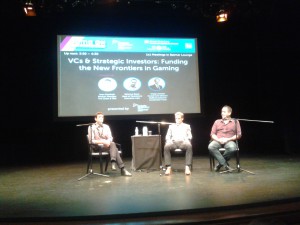Digi players talk tax credits, private investment and VR at GameON
Ontario's digital companies talk tax credits and shifting platforms at the annual GameON conference in Toronto.
By Jordan Pinto and Julianna Cummins
While federal and provincial tax credits have largely been successful in building a digital media industry in Ontario, producers should now look to what comes next in regards to financing, said Smokebomb VP digital Jay Bennett at the GameON: Ventures conference on Wednesday morning.
“We can make content that can compete everywhere in the world…and I think what we need as an industry now is to support that. I think we need to be building out our own platforms, I think we need to be asking ourselves why we don’t have the interest in private investment the same way they do in the U.S. It’s not just a population base – there is something culturally missing here right now. And if we can start to solve those things in the next few years, I think it is an exciting time,” Bennett said during a panel focused on the future and financing models for digital media.
The panel also touched upon the recent changes made to the Ontario Interactive Digital Media Tax Credit. The spring 2015 Ontario budget put greater restrictions on the kind of projects that are eligible for digital media projects, while also dedicating more funding to the program overall. While there was general consensus among the panelists that changes were necessary, there are enough loopholes in the credit to create some uncertainty, said Jason Loftus, CEO of Mark Media.
“There are a lot of these unintentional oversights that can create a lot of uncertainty, especially when you are financing projects years out,” Loftus said. Bennett also echoed a similar sentiment about the changing definition of what “interactive” means, pointing to an in-development Occulus Rift VR extension for the horror series Slasher Smokebomb is currently working on as something that may fall outside rigid categories.
On the topic of VR, Behrouz Bayat, head of operations at Montreal-based Execution Labs indicated during a panel on Tuesday that market conditions are not quite tuned in to the new tech. In terms of commercial appeal right now, VR is the shiny new toy that most gamers want to try – but the jury is still out on how much money can be made in VR, said Bayat. With Sony, Oculus and Samsung products all set to hit the market within the next year, it is still an uncertain time for the market, especially for those companies developing apps for VR.
With few consumers owning VR viewers to date, and an early adopter curve ahead, the market is likely to be oversaturated in early 2016, Bayat said.
Bayat’s advice to game developers is to collaborate with the platform-holders, for example Oculus, and work within the parameters and guidelines set by the companies. The uncertainty surrounding VR-induced nausea is also somewhat of an unknown. “It’s bad PR for companies if a game comes out that makes a quarter of the population sick,” he said.
There was also general consensus from the panel that mobile is no longer direction in which the gaming industry is headed. At last year’s conference, a lot of the buzz was around building apps for mobile devices, noted moderator Sean Stanleigh, product manager, The Globe and Mail. The shift away from mobile has only become discernible over the past 12 months, Bayat said.
“Nowadays, there’s a lot less success to be found on mobile and so we’re seeing a shift back towards more traditional markets like Steam, PC as well as console. On mobile platforms it’s just incredibly difficult to be discovered among the hundreds of apps that come out every day. There was the gold rush a few years ago and everyone went to mobile to make games – but app developers are realizing that they’re failing and failing rather hard on mobile, and so they’re heading to PC,” he said.


 The definitive CDN broadcast and production resource.
The definitive CDN broadcast and production resource.










